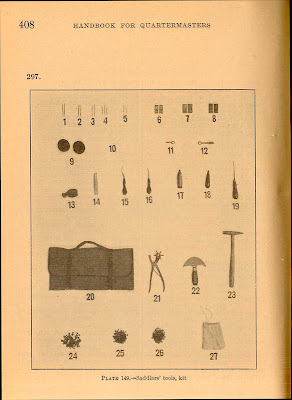Couvi's Blog
About Me
- Name: Couvi
- Location: Alabama, United States
I am older than dirt and approaching retirement. I intend to drive my wife over the edge with discussions of saddles, mules and the repair of Army leather work.
Sunday, September 16, 2007
HANDBOOK FOR QUARTERMASTERS-1930
I. Administrative
II. Supply
III. Transportation
IV. Construction
V. Miscellaneous Information
These scans are from the Handbook for Quartermasters, 1930:
 Plate 119. Cantle bag, M-1917.
Plate 119. Cantle bag, M-1917.
Plate 120. Cavalry bridle, M-1909 Plate 121. Field Artillery Bridle (for individual mounts), M-1914.
Plate 121. Field Artillery Bridle (for individual mounts), M-1914. Plate 122. Bridle and martingale, M-1920.
Plate 122. Bridle and martingale, M-1920. Plate 123. Riding bridle, quartermaster.
Plate 123. Riding bridle, quartermaster. Plate 124. Halter, complete, M-1904.
Plate 124. Halter, complete, M-1904. Plate 125. Halter, headstall, quartermaster.
Plate 125. Halter, headstall, quartermaster. Plate 126. Leading harness, veterinary (half of a set).
Plate 126. Leading harness, veterinary (half of a set).
Will some knowledgeable person please explain what this is for?
 Plate 127. Pommel Pockets, M-1917.
Plate 127. Pommel Pockets, M-1917. Plate 128. Saddlebags, M-1904.
Plate 128. Saddlebags, M-1904. Plate 129. Quartermaster saddlebags.
Plate 129. Quartermaster saddlebags. Plate 130. Officers’ field saddle, M-1917.
Plate 130. Officers’ field saddle, M-1917.
 Plate 131. Cavalry McClellan saddle, M-1904.
Plate 131. Cavalry McClellan saddle, M-1904. Plate 132. Cavalry McClellan saddle, M-1904 modified.
Plate 132. Cavalry McClellan saddle, M-1904 modified.
Note that it is not yet called the M-1928.
 Plate 133. Field Artillery McClellan saddle, M-1904.
Plate 133. Field Artillery McClellan saddle, M-1904. Plate 134. Riding saddle, mule, M-1913.
Plate 134. Riding saddle, mule, M-1913. Plate 135. Riding saddle, packers’, full rigged.
Plate 135. Riding saddle, packers’, full rigged.
 Plate 136. Riding saddle, packers’, skeleton rigged.
Plate 136. Riding saddle, packers’, skeleton rigged. Plate 137. Training saddle, M-1916.
Plate 137. Training saddle, M-1916.
 Plate 138. Training saddle, M-1926.
Plate 138. Training saddle, M-1926.
 Plate 139. Watering tank, M-1925.
Plate 139. Watering tank, M-1925.
The watering tank is one of the loads carried on the Phillips Pack Saddle (Cavalry type).
Sunday, September 09, 2007
My Grandfather’s Syrup Mill
 The enclosed are photographs of my Grandfather, Ulysses Samuel Couvillion’s syrup mill on Yellow Bayou in Central Louisiana. He is the one in the middle with the white apron, a neighbor, Joe Voiselle, is to his left. The rollers are used to crush the sugar cane, fed into the machine by the small boy in the middle of the photograph. Note one cane is going through the crusher. The mule, or mules, walks around the mill to provide power for the crusher.
The enclosed are photographs of my Grandfather, Ulysses Samuel Couvillion’s syrup mill on Yellow Bayou in Central Louisiana. He is the one in the middle with the white apron, a neighbor, Joe Voiselle, is to his left. The rollers are used to crush the sugar cane, fed into the machine by the small boy in the middle of the photograph. Note one cane is going through the crusher. The mule, or mules, walks around the mill to provide power for the crusher.

The caption on the back reads: “U.S. Couvillion, Jr. (Brother), Huey Riche, (Neighbor) and Joseph Bordelon (neighbor) at Syrup Mill.”
The juice from the crushed cane goes through a pipe to a holding barrel and is let into a baffled pan. The fire under the pan was maintained by Jules “Sweet Papa” DuFour at about 1,000°. As the juice traveled through the pan the water was boiled off and thickened. Using a hygrometer and a lot of experience Papa Sam drained the syrup. It was canned by Henry “Guy (pronounced “Gee”) Couvillion.
Tuesday, July 24, 2007
No More Horses
The 240mm Howitzer, Model of 1918, was of French design and American manufacture. The weights of the various loads made transportation by horse traction a practical impossibility. The advent of mechanical traction, not tied to railroads, made moving the larger artillery weapons more practical.



The platform was sunk into a pit and required considerable labor to install it. The weight of the entire unit was 41,296 lbs (18,771 kilos). The weights of each load ranged from 12,545 lbs to 16,320. The recoil system was hydro-pneumatic and its action was described as that of taking a railroad locomotive traveling at 105 miles per hour, stopping it in 36 inches and returning it to its point of origin without damage. Impressive in any era.


Maximum elevation is 60 degrees (1066 mils) and traverse is 10 degrees (178 mils) left or right of center. There is a lot of that bad boy in the ground.
Range was 16,000 yards or 14,770 meters.
Saturday, June 09, 2007
DEAD MEN'S GUNS
The M1909 Colt .45 that once belonged to General Julio Cardenas, the head of Villa's bodyguard. Cardenas was Captain of the "Doradoes" the Golden Ones, the "bodyguard" for Francisco Villa. In accordance with typical Mexican Revolutionary decorum, he was called "General" Cardenas. General Cardenas and another Villista were killed by 2LT Patton using the single-action Colt he had purchased in March, 1915.
The M1909 Colt was taken from Cardenas’ body by Patton,
Wednesday, June 06, 2007
MORE PATTON PISTOLS











 Plate 106.-- Harness, pontoon, 6-mule, swing (half of double set)
Plate 106.-- Harness, pontoon, 6-mule, swing (half of double set) 










